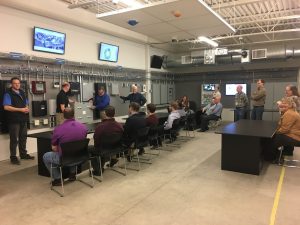Commercial buildings, retail spaces, and warehouses spend on average one-third of their operating costs on energy usage, including lighting, refrigeration, heating, cooling, and water heating. With new technology and building automation solutions, energy efficient initiatives can improve a building’s decarbonization, lower operating costs, and improve the overall environmental impact. Transitioning to energy efficient infrastructure is a strategic move that many businesses are implementing as they look ahead and prepare for the future.
INCORPORATE BUILDING AUTOMATION
Building automation systems (BAS) are one of the leading technologies in commercial energy efficiency initiatives. Integrating with smart technology, these systems enable easy monitoring and control of building functions, including lighting, heating, and cooling. The right BAS optimizes the energy efficiency within a facility, making adjustments based on internal and external conditions such as building occupancy, weather, and time of day.

Building automation systems can be controlled from a singular point, even across multiple buildings, making them user-friendly and accessible for a variety of corporate campuses, schools, and retail spaces. Connecting to an automation system can improve the energy efficiency, operating costs, and comfort within your facility, which can result in long-term payoffs for your business.
UPGRADE LEGACY PNEUMATIC SYSTEMS
Buildings that haven’t switched their Automation systems from pneumatic to direct digital control (DDC) equipment have a real opportunity to increase their energy efficiency, improve total building operating costs, and increase the comfort of the facility. Outdated compressors require a lot of energy to run, and they are less reliable and precise in air handling than their digital counterparts. By converting to a new DDC system, buildings can see a significant improvement in air flow, comfort, maintenance, and operating costs all year round.
ENERGY-EFFICIENT TECHNOLOGIES
Finally, upgrading to energy efficient technology and equipment can improve the total operating costs and energy efficiency of your building. Switching to LED lighting is an easy way to upgrade your commercial facility. Smart technology, including thermostats and energy monitoring systems, can enhance the maintenance of the property and provide a better experience for occupants. Based on local power companies and state availability, rebates are available for commercial facilities who integrate energy efficient lighting, HVAC, and other technologies. Contacting your local utility provider is the best way to learn what is available for your building.
IMPROVE YOUR BUILDING’S ENERGY EFFICIENCY
Finding energy efficient solutions for your commercial property can help you keep your energy consumption and costs down, especially through extreme weather conditions that often occur in Minnesota. As a local electrical, mechanical, and building automation contractor and systems integrator in Champlin and Rochester, Minn., Egan Company understands the importance of keeping commercial buildings updated with new technologies and building automation systems. Whether you are looking for complete system upgrades, or need regular equipment and facility maintenance and service, our team can help. Let’s work together to create a more comfortable environment for your customers and employees, while improving your building’s operating costs with energy efficient solutions.






 With ever-evolving technology, it is essential for companies to provide employees the tools to improve and enhance skills. Egan Company has built a Technology Center to provide employees a way to grow skills and learn more about popular, and some new, systems used on Egan projects.
With ever-evolving technology, it is essential for companies to provide employees the tools to improve and enhance skills. Egan Company has built a Technology Center to provide employees a way to grow skills and learn more about popular, and some new, systems used on Egan projects.
 Anoka-Hennepin School District #11 (A-H) is one of the largest in Minnesota, encompassing 45 schools and close to 39,000 students (or about 5% of total public school enrollment in the state). For the past 27 years, Egan Company has been the district’s sole integrator of building automation systems.
Anoka-Hennepin School District #11 (A-H) is one of the largest in Minnesota, encompassing 45 schools and close to 39,000 students (or about 5% of total public school enrollment in the state). For the past 27 years, Egan Company has been the district’s sole integrator of building automation systems. It’s our responsibility to respond in a meaningful way when we get called upon to help.
It’s our responsibility to respond in a meaningful way when we get called upon to help. His actions that Thanksgiving represent one of many moments where Egan technicians have delivered on a personal commitment to ensuring success for our customers.
His actions that Thanksgiving represent one of many moments where Egan technicians have delivered on a personal commitment to ensuring success for our customers.